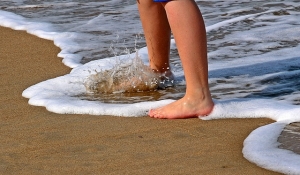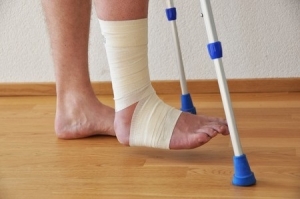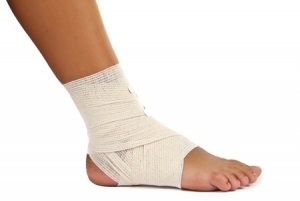Connect With Us
Blogs
Displaying items by tag: ankle sprain
Dealing with Chronic Ankle Pain
You haven’t sprained your ankle—at least not recently—but it hurts and is stiff and swollen at times. This is a complaint we at Superior Foot & Ankle Care Center sometimes hear from our Los Angeles county patients. When an ankle sprain occurs, our podiatrists, Dr. Victoria M. Foley and Dr. Constance Ornelas always stress the importance of prompt and complete rehabilitation. Many chronic ankle issues stem from a previous injury. Below are two types of chronic ankle trouble and what to do about them.
Chronic Lateral Ankle Pain
The characteristic symptom of chronic lateral ankle pain is pain along the outside of the ankle. You may also experience discomfort in your leg along with stiffness, swelling, and tenderness in the ankle. Many patients also report that their ankle feels like it is unstable or going to “give way” especially when walking on surfaces that are not level or when wearing heels. Although the most common cause of chronic lateral pain is a past sprain or injury, there are other possible sources, including:
- Fractures in the ankle joint bones
- Arthritis or inflammation in the joint, joint lining or tendons
- Nerve damage
- Scar tissue
Treatment Options: The treatment for chronic lateral ankle pain will depend on the source. If the podiatrist finds a break in a bone, it may be necessary to immobilize the ankle to allow the bone to heal. Other possible treatments include:
- Anti-inflammatory medications or a prescription steroid
- Physical therapy
- Ankle brace or another type of support
Osteochondritis
The symptoms of osteochondritis often mimic those of an ankle sprain: pain, stiffness, and swelling in the ankle joint. You may also find it difficult to bear weight on the ankle. This condition can affect people at any age and is almost always due to a previous sprain that may have caused lesions or a stress fracture on the surface of the joint.
Treatment Options: The foot doctor will first want to x-ray the ankle that’s bothering you to check for fractures or other injuries. This can be done right in our Long Beach office. At a minimum, the ankle will likely have to be immobilized to rest the joint and allow it to heal. In severe cases, surgery may be necessary to remove bone fragments or cartilage, stimulate new blood vessels, and promote scar tissue.
If you are experiencing ongoing ankle pain or stiffness, contact our Long Beach office at (562) 420-9800 to schedule an appointment.
Holiday Season Do’s and Don’ts for Healthy Feet
Although the radio may be proclaiming “It’s the Most Wonderful Time of the Year,” we at Superior Foot & Ankle Care Center know that the feet of our Los Angeles County patients may not agree. It’s a time of year with lots of extra errands to run, cooking and shopping to do, and being on your feet for longer periods than usual. However, you can sail through the season feeling “merry and bright” if you follow the do’s and don’ts below to keep your feet and ankles healthy and pain-free.
Do: go easy on holiday feasting. Yes, there will be lots of delicious sweets and treats on the menu, but come January extra weight gain could result in added stress and pain for your feet. Many common conditions such as plantar fasciitis, sesamoiditis, and metatarsalgia are all aggravated by carrying additional pounds. If you suffer with diabetes or gout, you need to pay particular attention to what you put on your plate. Go for small quantities of your favorites to savor and compensate by not loading up on unnecessary carbohydrates. Avoid going back for seconds!
Don’t: allow your feet to stay in damp socks. Whether you’ve stepped in a puddle or your feet are sweating during a long day of shopping, it’s essential to not let feet stay where it’s moist. Damp, dark, closed-in spaces (like the insides of your shoes) are the perfect breeding ground for fungal infections. Pack an extra pair of socks and change into them when you notice feet feel sweaty. Use foot powder before you put on socks.
Do: carefully consider footwear choices. When you know you’re going to be on your feet for several hours or doing an above-average amount of walking, make sure the styles you choose are comfortable and have good arch support and non-stick treads. Limit the amount of time in high-heeled party shoes!
Do: leave extra time in your schedule for making appointments. Rushing is when you’re most likely to not see an object in your path which can cause an ankle sprain or other injury.
Don’t: put off getting foot pain evaluated by our podiatrists, Dr. Victoria M. Foley and Dr. Constance Ornelas. This can result in a podiatric problem getting worse and potentially requiring longer and more invasive treatments. Make an appointment at our Long Beach office by calling: (562) 420-9800 today.
Helpful Hints for Hikers
Hiking is a great way to stay in shape, spend time with family and friends, and appreciate the beauty of nature. At Superior Foot & Ankle Care Center, we want our patients to keep their feet safe while enjoying this activity. Below are some recommendations before you hit the trail.
Shoe Sense—it all starts with the right hiking shoes or boots. The terrain on trails can be steep, uneven, and unstable. It’s essential that you have the proper foot gear. Get professionally fitted and buy quality-hiking shoes that protect your feet from moisture, provide good support and shock absorption, and have a tread to help prevent slips and slides. If you have chronic foot problem such as weak ankles or heel spurs, see our podiatrists, Dr. Victoria M. Foley or Dr. Constance Ornelas get recommendations for shoe styles and other modifications that will best accommodate your condition.
Proper Planning—if you are planning to hike on a trail you’ve never been on, study a map to determine the length of the trail, whether it’s “in and out” or a circle, the elevation, and how the trail is maintained. Take into consideration your current physical condition and don’t overdo it. Warm-up and stretch before starting a hike to avoid injuries like Achilles tendonitis.
Knapsack Know-How—in addition to granola bars and plenty of water (which will not only keep you hydrated but also reduce the chances of painful swelling in your feet and ankles), you should include a few other items in your backpack. Blisters, though small, can ruin a hike. Pack moleskin and use it as soon as you notice rubbing or a sore spot on your foot. It’s also a good idea to have wraps or elastic bandages in case of an ankle sprain and bandages and antibiotic ointment for minor scrapes or insect bites.
Foot and ankle injuries require immediate medical attention. If you fall, twist an ankle, or injure your feet or ankles in any way while hiking, contact our Long Beach office in Douglas Park, CA by calling (562) 420-9800 as soon as possible. Until you can get in to see us, follow the RICE regimen: Rest, Ice, Compression, and Elevation.
Beach Day or Bust?
At Superior Foot & Ankle Care Center, we know that many of our patients like to relax by spending a day at the beach. However, besides rain, nothing ruins a beach day faster than a foot or ankle injury. Below are some easy ways to avoid foot trouble and enjoy some fun in the surf and sand.
Watch out for Jellyfish—a dead jellyfish that has washed up on the shore through its tentacles can still sting you. If this happens, use gloves to protect your hands and gently remove the tentacles. Apply vinegar or baking soda to help the pain and swelling decrease.
Wear Flip Flops—this is one of the few times that you will hear us recommend flip-flops, but for a beach day, they can help your feet in several ways:
- Getting from the car to your beach blanket, they will prevent the soles of your feet from being burned by the hot asphalt or the sand that’s been baking in the sun.
- For walks on the beach, flip-flops can protect your feet from cuts from sharp shells and puncture wounds from debris hidden in the sand.
- When using the changing area or restroom, flip-flops will keep you from coming in contact with bacteria, viruses, and fungus that cause athlete’s foot, warts, and other
Re-Apply Sunscreen—a water-resistant sunscreen that has an SPF of 15 or higher should be used on the tops and bottoms of your feet if you are laying out on the beach. To be effective in preventing sunburn, it needs to be reapplied every two hours, and after each time you take a dip in the ocean.
Bring Sneakers—if beach volleyball, Frisbee or other active games are part of your idea of fun at the shore pack sneakers in your beach bag. Wearing flip-flops or playing barefoot can increase your risk for an ankle sprain in the shifting sands.
Remember Your Water Bottle—drinking lots of water is not only essential for staying hydrated, it helps you avoid swelling of the ankles and feet which can be painful and make it difficult to fit into your shoes for the ride home.
If your beach day results in an injury, rash or other foot or ankle symptoms, make an appointment at our Long Beach office (562-420-9800) promptly so that our podiatrists, Dr. Victoria M. Foley or Dr. Constance Ornelas can examine your feet and treat any podiatric problems.
In Case of Sprains Use RICE
At Superior Foot & Ankle Care Center, we often see patients with chronic ankle problems such as weakness, instability, and pain, which can be traced back to an old ankle injury that was not treated and rehabilitated promptly. An ankle sprain occurs when the bones twist and ligaments surrounding them are overstretched or even torn. There are various levels of severity of sprains, but one thing they all in common is the need for immediate treatment to facilitate full and proper recovery.
If you suffer an ankle-twisting injury, you should contact our Long Beach office as soon as possible after the injury so that one of our podiatrists, Dr. Victoria Foley or Dr. Constance Ornelas can evaluate the damage. While you wait for your appointment, your first line of treatment is to follow the RICE regimen:
REST—stay off the injured ankle as much as possible. Do not try to walk or bear weight on the foot or you may make the injury worse or even cause a secondary injury to occur.
ICE—ice can help relieve pain and swelling. Do not apply ice directly to your skin. Wrap an ice pack in a thin towel and apply to the injured ankle for 20 minutes at a time with at least 40 minutes off between icings.
COMPRESSION—wrapping the injured ankle in a compression bandage can help support the ankle and limit motion. It may also reduce swelling. Make sure the wrap is not too tight. There should not be swelling occurring above or below the bandaged area.
ELEVATION—keep the ankle raised or propped up on pillows to a level that is slightly above your heart. This will reduce swelling.
Once the foot and ankle surgeon has examined your ankle, the best treatment plan for your injury can be determined. It may include physical therapy to retrain the ligaments and strengthen surrounding muscles. In the case of a severe sprain, surgery may be needed to repair the damage. Don’t delay if you have suffered a sprain. Contact us by calling: (562) 420-9800.
Wimbledon Contender Plays it Smart
You didn’t see South Korea’s Chung Hyeon at Wimbledon early this month. That’s because he pulled out at the last minute due to an ankle injury that was not fully rehabilitated. At Superior Foot & Ankle Care Center we think Mr. Hyeon is a winner for making that choice. Chronic ankle pain and instability is most often the result of a prior ankle sprain or strains or other ankle injuries that were not fully healed before the patient resumed normal activities. A mistake that many patients make is stopping their physical therapy once the ankle is pain-free. However, in addition to healing the injury and retraining the ligaments of the ankle, it’s essential to strengthen the muscles surrounding the ankle to help prevent future twists and injuries. This takes time and when patients terminate physical therapy before this occurs they open themselves up to the possibility of repeated ankle injuries.
Recognizing Chronic Ankle Issues
While some symptoms of a chronic ankle problem are obvious, some are subtler. For example, lower leg pain and pain on the outside of the ankle may indicate an ankle issue. Other symptoms include:
- Stiffness or tenderness in the ankle on a regular basis
- Swelling of the ankle area
- A feeling that your ankle is going to “give way,” or repeatedly twisting your ankle on unlevel surfaces or when wearing high heels
Treatment Options
If you are having intermittent or ongoing ankle discomfort, it’s important that you make an appointment with one of our foot and ankle surgeons, Dr. Victoria Foley and Dr. Constance Omelas to have your ankle evaluated. In addition to physically examining your ankle for tenderness and swelling, the foot doctor will ask questions about previous ankle injuries. She may also wish to get an x-ray or other imaging studies to get a clear picture of the condition of your ankle. Once the podiatrist knows the state of your ankle a treatment plan that best suits you can be developed. It may include:
- Over the counter or prescription medications to take temporarily to reduce inflammation and swelling
- Ankle braces or supports to increase stability
- Physical therapy and exercises to strengthen muscles and improve range of motion.
To learn more, contact our Long Beach office by calling: (562) 420-9800.
Protect Your Ankles
When you twist your ankle bones with a significant amount of force the ligaments around the outside of the bone may get over stretched or even tear. This is the definition of an ankle sprain. Symptoms of a sprained ankle include swelling, bruising, pain and tenderness in the ankle. At Superior Foot & Ankle Care Center we know that these injuries can be painful and debilitating. That’s why we want to offer the suggestions below for preventing ankle sprains from happening:
- Seek treatment promptly if you believe you may have sprained your ankle. Being able to walk on your foot is not a sign that the ankle is okay. In fact sometimes the pain may decrease after the initial injury but a sprain that is not diagnosed and treated promptly may not heal properly.
- Finish all treatment prescribed by the podiatrist for an ankle sprain. Did you know that one of the chief causes of ankle sprains are previous ankle sprains that were not fully rehabilitated? Don’t make the mistake of discontinuing physical therapy just because you are no longer in pain. In addition to the overstretched ligaments being healed it is necessary for the muscles that support the ligaments to be retrained and strengthened. If this does not occur, repeated sprains are likely and can result in chronic weak ankles.
- Scope out your path. Sometimes an acorn or small stone can be enough to cause your ankle to turn. Uneven pavement and curbs are also prime ankle twisting culprits. Pay attention!
- Don’t overfill your arms. If you are carrying so many bags and packages that you can’t see the pavement in front of you a slip or ankle turn is more likely.
- Toss shoes that are worn out. Stretched out backs and loose stitching increase the risk of slips and your ankle giving out on you.
If, despite all precautions, you do twist your ankle, contact our Long Beach office as soon after the injury as possible by calling: 562-420-9800. Our podiatrists, Dr. Victoria Foley and Dr. Constance Omelas will examine your ankle and possibly order x-rays to diagnose the condition. The correct treatment can then be determined to get you back to full health.
Dealing with Chronic Ankle Problems
At Superior Foot & Ankle Care Center many patients come to us with ankle pain and discomfort saying, “But I didn’t twist my ankle or fall—I don’t know why it hurts.” Chronic ankle problems can include the following symptoms:
- Stiffness
- Pain or soreness
- Feeling of instability—like the ankle is going to “give way”
- Swelling
These may be signs of osteochondritis, chronic lateral ankle pain, “weak ankles” or another chronic ankle condition.
What’s Behind the Pain?
Most often, chronic ankle problems affect patients who have had one or more ankle sprain injuries in the past, leaving them with scar tissue or nerve damage in the ankle. In many cases ankle sprains are either not treated promptly or rehabilitated fully, leaving the patient more likely to experience repeated sprains or ongoing ankle pain and discomfort. Other common sources of chronic ankle pain include: arthritis or other condition that causes joint inflammation or an undiagnosed ankle fracture.
Getting Relief
The first step is to have one of our podiatrists, Dr. Victoria Foley and Dr. Constance Omelas evaluate your ankle. The foot doctor will want to get a detailed medical history and will be particularly interested in knowing about any previous ankle injuries or problems. X-rays or other imaging studies may be made to get a more complete idea of the condition of your ankle.
Once the podiatrist has diagnosed your chronic ankle problem a treatment plan that best suits your condition and lifestyle can be developed. Treatment options may include one or more of the following:
- Anti-inflammatory or steroidal medications to relieve swelling and relieve pain
- Immobilizing the ankle to allow healing
- Physical therapy to improve range of motion and strengthen supporting muscles
- Ankle braces or supports
If you are suffering with ongoing ankle pain, stiffness or weak ankles, don’t assume nothing can be done about it. Make an appointment at our Long Beach office today by calling: 562-420-9800 and find out how you can get relief and resume the active lifestyle that you love.








